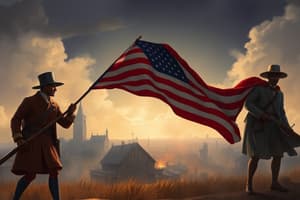Podcast
Questions and Answers
The USA won independence from Britain in ______.
The USA won independence from Britain in ______.
1776
The northern states consisted of areas north of ______.
The northern states consisted of areas north of ______.
Pennsylvania
The southern states relied heavily on ______ for their agricultural economy.
The southern states relied heavily on ______ for their agricultural economy.
slave labour
The northern states underwent an industrial revolution between ______ and 1860.
The northern states underwent an industrial revolution between ______ and 1860.
The North had a strong ______ movement that opposed slavery.
The North had a strong ______ movement that opposed slavery.
Slaves in the USA were treated as ______ of their owners.
Slaves in the USA were treated as ______ of their owners.
The North wanted to impose a protective ______ to support their industries.
The North wanted to impose a protective ______ to support their industries.
The admission of new states like Texas and California led to conflicts over their status as ______ or slave states.
The admission of new states like Texas and California led to conflicts over their status as ______ or slave states.
Due to their economic reliance on agriculture, the southern states primarily grew ______ crops.
Due to their economic reliance on agriculture, the southern states primarily grew ______ crops.
The differences between the North and the South ultimately led to a ______.
The differences between the North and the South ultimately led to a ______.
Abraham Lincoln was elected as the 16th president of the United States in ______.
Abraham Lincoln was elected as the 16th president of the United States in ______.
The southern states formed the ______ States of America after seceding from the Union.
The southern states formed the ______ States of America after seceding from the Union.
The attack on Fort ______ marked the beginning of hostilities in the Civil War.
The attack on Fort ______ marked the beginning of hostilities in the Civil War.
In April 1861, Lincoln ordered the Union navy to close the ports of the Southern ______.
In April 1861, Lincoln ordered the Union navy to close the ports of the Southern ______.
The ______ Proclamation, issued by Lincoln in 1862, freed the slaves in the southern states.
The ______ Proclamation, issued by Lincoln in 1862, freed the slaves in the southern states.
The Battle of ______ is considered a turning point in the American Civil War.
The Battle of ______ is considered a turning point in the American Civil War.
In 1865, the southern states submitted, and slavery was finally ______ in the USA.
In 1865, the southern states submitted, and slavery was finally ______ in the USA.
The Civil War left the southern states greatly ______.
The Civil War left the southern states greatly ______.
Following the Civil War, the period of American history that focused on rebuilding the South is known as ______.
Following the Civil War, the period of American history that focused on rebuilding the South is known as ______.
Abraham Lincoln delivered the famous Gettysburg ______ during the dedication of the military cemetery.
Abraham Lincoln delivered the famous Gettysburg ______ during the dedication of the military cemetery.
Flashcards are hidden until you start studying
Study Notes
Development of Northern and Southern States
- Northern states encompassed areas north of Pennsylvania; Southern states covered territories south of Maryland.
- Southern economy was heavily agricultural, focusing on plantation crops like cotton, rubber, and tea, relying on slave labor.
- Northern states experienced an industrial revolution (1815-1860) with factories, urbanization, and a labor force of wage-earning skilled workers.
- Strong anti-slavery movement in the North, leading to the practical abolition of slavery by that region.
Causes of the American Civil War
- Slavery: Central issue of conflict; harsh treatment of slaves, lack of rights, and fear of punishment for escape fueled the abolition movement.
- Taxes: Disputes over tariffs; Northern states sought protective tariffs to protect their industries while Southern states opposed them due to increased costs.
- Admission of New States: Controversy over whether new states (e.g., Texas, New Mexico, California) would be free or slave states heightened tensions.
- Election of Abraham Lincoln: Lincoln's anti-slavery stance alarmed Southern states; led to the secession of 11 Southern states forming the Confederate States of America in 1861.
- Attack on Fort Sumter: Marked the start of hostilities in 1861 when Southern forces fired on this federal fort, prompting war declaration by Lincoln.
Key Events in the Civil War
- Blockade: Lincoln ordered a naval blockade of Southern ports in April 1861, severely restricting Southern trade and resources.
- Emancipation Proclamation: Issued by Lincoln in 1862, it declared the freedom of slaves in Southern states, gaining support for the Union cause.
- Battle of Gettysburg: Fought in June 1863; significant Union victory with over 45,000 casualties, deemed a turning point in the war.
- Gettysburg Address: Lincoln delivered a pivotal speech at the cemetery dedication, reinforcing the principles of equality and national unity.
- Final Submission of Southern States: After four years of conflict, Southern states surrendered in 1865; led to the formal abolition of slavery.
Effects of the Civil War
- Slavery was abolished across the USA, effectively ending the institution.
- Preservation of the unity of the United States was achieved.
- Southern states were left in ruins, prompting a period of reconstruction to rebuild and reintegrate them into the Union.
Studying That Suits You
Use AI to generate personalized quizzes and flashcards to suit your learning preferences.



